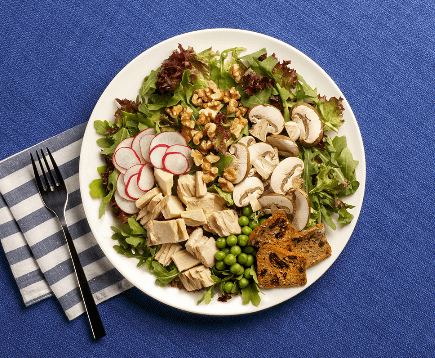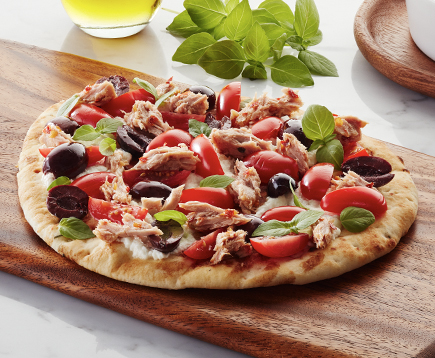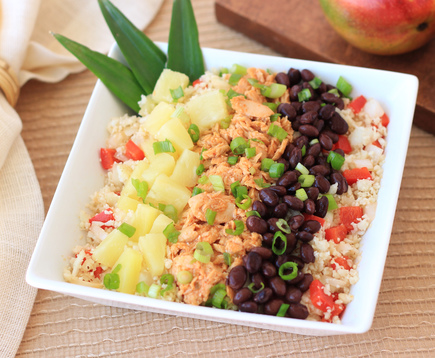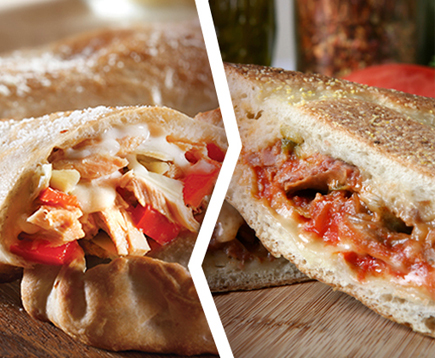By: Laura Ali, MS. RND, LDN
5 Exceptional Nutrients in Canned and Pouch Tuna and Their Health Benefits
Is canned tuna really healthy? Absolutely and here is why it is such a healthy option.
This pantry staple is full of protein, vitamins and minerals, and heart-healthy omega-3 fatty acids DHA and EPA. While a treasure trove of nutrition it is also an easy and convenient food that can make including this healthy food into your diet a breeze.
Let’s dive right in and look at 5 amazing nutrients and the health benefits of tuna. We’ll also explore the different types of tuna you can find in the tuna aisle and some delicious ways you can include tuna in your meals, topping it off with a yummy recipe you can whip together for tonight’s dinner.
What are the top 5 nutrients in tuna and what do they do?
Tuna is a hidden treasure full of nutrition. From vitamin D, which supports bone health and boosts your mood, to B vitamins that give you energy and help your body function like a well-oiled machine. Let’s take a deep dive into 5 of the most important nutrients in canned tuna and their health benefits.
1. Lean Protein
First things first, canned tuna is packed with lean protein. Protein helps repair and build tissues, supports muscle growth, and keeps you feeling satisfied and full. So if you’re aiming to build muscle, lose or maintain weight, or simply maintain a healthy body, canned or pouch tuna is a superb option.
2. Omega 3s
Now, let’s talk about one of the real treasures packed within those shiny cans and pouches: omega-3 fatty acids. These are the good fats that keep your heart happy and healthy. Tuna is brimming with two types of omega-3 fatty acids, DHA and EPA, which have been linked to reduced inflammation, improved brain function, and a lowered risk of heart disease.
3. Vitamin D
Did you know that tuna is one of the few natural food sources of vitamin D? It’s true! This sunshine vitamin is also found in abundance in seafood like tuna. Why is this important? Most people don’t get enough vitamin D and research is showing how important it is for not just our bones, but our immune system as well.
Some studies have shown that vitamin D helps protect against infections, supports a healthy gut, and may help decrease inflammation.
4. Selenium
This little talked about nutrient is a powerful antioxidant and plays an extremely important role in seafood. So, you’ve probably heard about mercury, right? Well, selenium and mercury are linked – but in a good way. Selenium ties up or binds mercury so your body can’t absorb it. Pretty cool right? And even better, tuna has way more selenium than mercury so there is plenty leftover to do all the other good things antioxidants do!
Like other antioxidants, selenium helps limit oxidation and oxidative damage and has been shown to support and strengthen our immune system. It has an important role in protecting our brain cells from oxidative damage and supports thyroid hormone development and cardiovascular health. Seafood is one of the best sources of selenium.
5. B Vitamins
You may know that B vitamins are great for helping your body use energy but did you know these 8 vitamins (yes there are 8 B vitamins and many are found in tuna!) may lower the risk of heart disease, help prevent anemia and may help reduce the risk of dementia. Tuna is a great source of vitamin B12, niacin and vitamin B6.
Did you know that B vitamins are not only incredible for boosting your energy, but these essential vitamins may also help reduce the risk of heart disease, anemia, and dementia? Yes, you heard it right! There are eight essential B vitamins, and tuna happens to have an abundance of three of these including niacin, B12 and B6.
Should you eat tuna every day?
We don’t recommend eating anything every single day! It’s a good idea to eat a variety of food to get all the nutrition you need. Seafood, including tuna, should be enjoyed 2 to 3 times a week.
What are the different varieties of tuna?
If the wall of canned tuna options seems confusing, you aren’t alone. There are 15 types of this wild fish and while they are all from the same family each species has different characteristics. Kind of like your brothers and sisters – you all belong to the same family but each one of you is unique.
Let’s take a look at the most common types found in the canned tuna aisle and some of the key differences. If you want to learn more check out our Tuna 101 infographic.
Light Tuna
Light tuna is usually from either skipjack tuna or yellowfin tuna.
Skipjack tuna is the most common type found in the canned tuna aisle. This is a small fish, usually 4 – 15 pounds. It is dark and meaty and is often compared to a chicken thigh in texture and flavor with a soft texture that is full of tuna flavor. You will usually see it sold as “chunk style” meaning it is cut into small pieces and packed in a can with water or oil.
Skipjack tuna is low in fat and has between 90 mg to 160 mg of omega-3s per serving.
Yellowfin tuna is a larger fish that has a bright yellow dorsal fin. It also has a yellow stripe down its side. It ranges in size from 20 pounds up to 200 pounds. It is prized for its delicate flavor and texture. You’ll typically see it as a solid piece of tuna packed in a can with olive oil, like our Yellowfin in EVOO.
Yellowfin tuna is slightly higher in fat than skipjack and as a result provides a bit more omega-3s – around 250mg per 4 oz. serving.
White Tuna
Albacore tuna is also labeled as white tuna due to its very light, almost white color. It is the only variety that is allowed to be called “white tuna.” It is a larger fish that is anywhere from 20 – 40 pounds, although it can grow to be much larger.
Albacore is a very firm fish with a very mild flavor, similar to a chicken breast. It also has a higher fat content than light tuna and therefore is a bit higher in omega-3s. You’ll find 200mg to 300mg of DHA and EPA omega-3s per 4 oz serving.
Oil-packed vs. Water packed
A common question is which is better, oil-packed tuna or water-packed? It really is a matter of preference. Water-packed tuna became popular back in the 1960s because of its lower calorie content. It was marketed as a perfect food for weight loss. But, you lose a lot of flavor and even some nutrition when you forgo the oil.
Yes, oil-packed tuna is higher in calories, but using it helps minimize or eliminate the need for heavy salad dressings and mayonnaise so you may end up eating fewer calories in the long run – plus, did we forget to mention how absolutely delicious oil-packed tuna is? And a bonus is that research has found when you combine oil with fruits and vegetables your body is better able to absorb some of the nutrients found in them.
Canned vs. pouch tuna
Your choice in the tuna aisle used to be simple – white or light tuna, water or oil-packed. But today, there are tons of flavor varieties that come in cans and pouches. What’s the difference? Very simply it’s all about the liquid and the packaging.
Pouch tuna comes in a flexible pouch that contains very little water or oil – it is mostly fish. It can be eaten right from the pouch and doesn’t need to be drained. It is processed the same way, meaning it is vacuum sealed and heat processed, just as the can is. It has a similar shelf life – so it is great for stocking in your pantry.
Cans on the other hand have a fair amount of liquid and are best used if they are drained before using. An exception to this is with some oil-packed varieties. Cans are great for feeding a crowd and perfect for the ultimate tuna noodle casserole or tuna burger, while pouches are ideal for on-the-go enjoyment and come in a wide variety of flavors!
A quick note about the flavored pouches. While they are slightly higher in sodium than plain tuna, you won’t end up using extra dressing or sauces to spice it up. In the long run you end up with less sodium in your meal. So don’t let the sodium in the seasoned pouches scare you off!
Some easy ways to add tuna to your diet
Now that we’ve uncovered the health benefits of canned tuna, let’s reel in some tasty ideas you can use to include it in your meals.
- Nutty Tuna Salad: Who doesn’t love tuna salad for lunch? Give this no-may version that is packed with nuts and raisins a try!
- Jalapeno Tuna Avocado Toast: Love avocado toast but want a boost of protein to go with it? Give this spicy jalapeno avocado toast a try!
- Tropical Tuna and Quinoa Bowls: Grain bowls are all the rage and tuna is the perfect protein to add. Pack up all your ingredients with a pouch of tuna and you’ve got lunch in no time.
- Dijon Mustard Tuna Salad Snack Board: Just want a little something to nosh on to get you through the afternoon? Go no further than this easy tuna salad snack board!
- Lemon Pepper Tuna Casserole: Looking for something familiar but with a twist? This zesty tuna casserole is a breeze to throw together!
Albacore Tuna Asian-Style Grain Bowl with Vegetables
1 can, 4.5 oz StarKist E.V.O.O.(R) Albacore Tuna in Extra Virgin Olive Oil
2 cups brown rice
¼ cup sliced English cucumber
¼ cup sliced red and yellow pepper
¼ cup shredded or julienned carrots
½ oz. microgreens
2 tbsp. chopped peanuts
Peanut sauce on the side
Fresh cilantro and lime wedges to garnish
Directions:
- Divide rice between 2 bowls or plates.
- Top each with ½ of the sliced cucumber, peppers, carrots and microgreens.
- Add ½ a can of the albacore tuna in extra virgin olive oil, drizzling part of the oil over top of the tuna.
- Add chopped peanuts on top and drizzle with peanut sauce if desired.
Serves: 2
Prep Time: 15 minutes
Cook Time: 15 minutes
Nutritional information: Calories: 440, Fat: 13g, Saturated Fat: 2.5g, Polyunsaturated Fat: 3.5g, Trans Fat: 0g, Cholesterol: 25mg, Sodium: 790mg, Carbohydrates: 57g, Fiber: 5g, Sugars: 5g, Added Sugars: 2g, Protein: 26g
Bottomline
Canned tuna is a healthy lean protein that is full of nutrients that are good for your heart, mind, and body! This pantry staple is something you can feel good about adding to your meals or enjoying as a snack a few times a week so go ahead and dive right in!
Check out all of our fun recipes and easy Tear and Pair ideas and make canned or pouch tuna a part of your weekly routine.
Laura M. Ali, MS, RDN, LDN is an award-winning food and nutrition communications consultant, culinary nutritionist, freelance writer, and recipe developer. She is the author of the highly rated cookbook, MIND Diet for Two, a cookbook with 65 recipes for boosting brain health. She works with consumers and health-focused companies to develop simple, delicious ways to incorporate healthy foods into everyday meals. Follow her on Instagram and Twitter: @LauraAli_RD and her blog at lauramali.com






